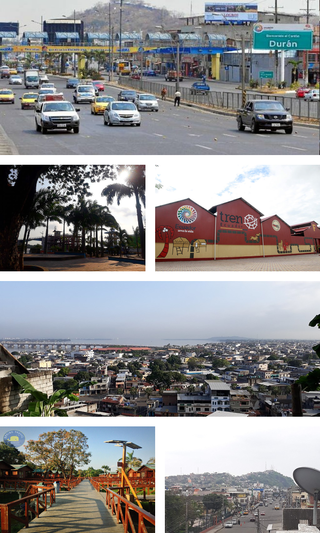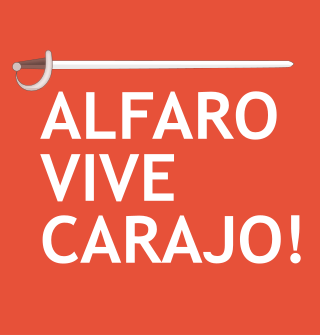
José Eloy Alfaro Delgado often referred to as "The Old Warrior," was an Ecuadorian politician who served as the President of Ecuador from 1895 to 1901 and from 1906 to 1911. Eloy Alfaro emerged as the leader of the Liberal Party and became a driving force for fairness, justice and liberty. He became one of the strongest opponents of the pro-Catholic conservative President Gabriel García Moreno (1821–1875). The "Viejo Luchador" played a central role in the Liberal Revolution of 1895 and fought against conservatism for almost 30 years.

Manta, also known as San Pablo de Manta, is a city in Ecuador, cantonal head of the Manta Canton, as well as the largest and most populated city in the Manabí Province. It is the seventh most populous in the country. Manta has existed since Pre-Columbian times. It was a trading post for the Manta, also known as Manteños.

Portoviejo, also known as San Gregorio de Portoviejo, is a city in Ecuador, and the capital of the Province of Manabí 30 km (19 mi) from the Pacific coast. It is still known as the city of the "Royal Tamarind Trees" due to former Tamarind plantains in the area.

Durán, also known as Eloy Alfaro, is the second largest city in the province of Guayas, Ecuador and the seat of Durán Canton. It is located near the confluence of the Daule & Babahoyo rivers, where the Guayas River enters the ocean, across the Guayas River from Guayaquil. The name "Eloy Alfaro" was chosen because of the Ecuadorian ex-president Eloy Alfaro Delgado. According to the National census in 2022, the city had a population of 295,211. Many of its inhabitants commute to other places for work and it can be considered a "dormitory town". However, many people who live in Durán find work within the canton by opening "comedores" or small restaurants, selling produce at the market, or even opening little stores with basic produce and house necessities. The towns Durán, Samborondón, and Guayaquil are connected by the bridge Rafael Mendoza Avilés.

Alfredo Pareja Diezcanseco — born Alfredo Pareja y Díez Canseco — was a prominent Ecuadorian novelist, essayist, journalist, historian and diplomat. An innovator of the 20th-century Latin American novel, he was a founding member of the literary Grupo de Guayaquil, which brought a new emphasis to realistic novels.

¡Alfaro Vive, Carajo! (AVC), another name for the Fuerzas Armadas Populares Eloy Alfaro, was a clandestine left-wing group in Ecuador, founded in 1982 and named after popular government leader and general Eloy Alfaro. The group was labeled as a terrorist organization for the Ecuadorian state during the period of the former president León Febres Cordero, existing between 1983 and 1991, years where they carried out various armed actions and criminal acts in Ecuador, with Colombian (M-19) and Nicaraguan influence. The group was initially formed sometime in the 1970s, but was not active militarily for the first few years of the 80's.

Chone is a town in the province of Manabí in Ecuador. Officially, La Real Santisíma Villa Rica de la Bendita Providencia de San Cayetano de Chone de esta nuestra Nueva Castilla in reference to Saint Cajetan and The City of Kings, called Pueblo Viejo de Chone or Señorío de Pechance was founded in the early days of the colonization. It is located in Ecuador's low-lying coastal region and plays an important CHONE transportation hub. It is about seven hours by bus from the capital city of Quito.

The Ferrocarriles del Ecuador Empresa Pública is the national railway of Ecuador. The railway system was devised to connect the Pacific coast with the Andean highlands. After many decades of service the railway was severely damaged by heavy rainfall during the El Niño in 1997 and 1998 and from general neglect as the Pan-American Highway siphoned off passengers.

Instituto Nacional Mejía is a public secondary educational institution of Quito. It was founded on June 1, 1897 by Eloy Alfaro Delgado, then president of Ecuador.

Manuel Enrique Félix López was an Ecuadorian businessman and politician.

Luis Ramón Félix López was an Ecuadorian doctor, politician and renowned writer who held many senior public positions in his country during his lifetime.

Edmond Catefort was a French entrepreneur settled in Ecuador, who participated in the economic and public live of Ecuador during the government of Eloy Alfaro.
Colonel Luís Vargas Torres was an Ecuadorian revolutionary and national hero and martyr in the cause of liberalism.

Jorge Pérez Concha was an Ecuadorian historian, biographer, writer, and diplomat.
José Amén-Palma is an Ecuadorian surgeon and medical researcher.
Croatian Ecuadorians are Ecuadorians who are descended from migrants from Croatia. There are approximately 4,000 Croats and their descendants living in Ecuador. One can mention two major periods of the immigration of Croats to Ecuador; the first one at the end of the 19th century and the early 20th century and the recent that started in the 1990s. During the first period, Croat immigrants were moistly traders from Dubrovnik, Split and the island of Vis who settled in agricultural parts of Ecuador, especially in the region of Manabí, and in the cities such Bahía de Caráquez, Chone, Manta, Portoviejo and Guayaquil, Cuenca and Quito. The current immigration of Croats began with their arrival in Ecuador and was largely motivated by the interest in the fish industry and the exploration of marine crustaceans. Most of these new immigrants come from the Adriatic coast, especially from Split, and are employed in the tuna and sardines processing industry. Ecuadorian Croats and their descendants have a high cultural and economic status in the society and are quite prominent, particularly in the agricultural and fishing fields, as well as in commerce and industry. Ecuador has a large fleet of ships for banana transportation; also fish and merchant vessels whose crew is also made up of Croats living in Guayaquil. They are, however, not registered as Croatian immigrants. In 2004 an association was established in Ecuador where Croats and their descendants often congregate.

Zoila Ugarte de Landívar, also known by her pseudonym Zarelia, was an Ecuadorian writer, journalist, librarian, suffragist, and feminist. She was the first female journalist in Ecuador. Together with Hipatia Cárdenas de Bustamante, she was a key defender of women's suffrage in Ecuador.

Efraín Andrade Viteri was an Ecuadorian painter known as "The Painter of the Négritude Esmeraldeña".

Oswaldo José de los Ángeles Castro Intriago was an Ecuadorian journalist, teacher, poet, statistician, translator/reviser, and novelist. He was instrumental in founding Chone's first newspaper, the cultural weekly El Iris; in organizing the first census of the city of Quito, Ecuador as president of its technical commission; and in promoting the United Nations' Food and Agriculture Organization as its liaison officer for Southern Latin America. While in retirement in Madrid, Spain, he published La Mula Ciega (1970), a loosely autobiographical novel about two teenagers coming of age in the early 1900s with Chone, Bahía de Caráquez, Quito, Guayaquil, and the Galápagos as backdrops.

















